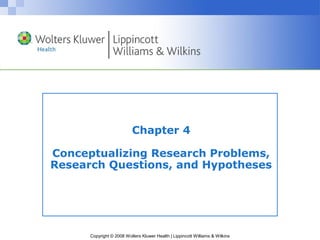
Po bech04
- 1. Chapter 4 Conceptualizing Research Problems, Research Questions, and Hypotheses Copyright © 2008 Wolters Kluwer Health | Lippincott Williams & Wilkins
- 2. Basic Terminology Research problem An enigmatic, perplexing, or troubling condition Problem statement A statement articulating the research problem and indicating the need for a study Copyright © 2008 Wolters Kluwer Health | Lippincott Williams & Wilkins
- 3. Basic Terminology (cont’d) Research questions The specific queries the researcher wants to answer in addressing the research problem Hypotheses The researcher’s predictions about relationships among variables Copyright © 2008 Wolters Kluwer Health | Lippincott Williams & Wilkins
- 4. Basic Terminology (cont’d) Statement of purpose The researcher’s summary of the overall study goal Research aims or objectives The specific accomplishments to be achieved by conducting the study Copyright © 2008 Wolters Kluwer Health | Lippincott Williams & Wilkins
- 5. Sources of Research Problems • Experience and clinical fieldwork • Nursing literature • Social issues • Theory • Ideas from external sources Copyright © 2008 Wolters Kluwer Health | Lippincott Williams & Wilkins
- 6. Developing and Refining Research Problems • Selecting a broad topic area (e.g., patient compliance, caregiver stress) • Narrowing the topic—asking questions to help focus the inquiry Examples: – What is going on with…? – What factors contribute to….? Copyright © 2008 Wolters Kluwer Health | Lippincott Williams & Wilkins
- 7. Evaluating Research Problems • Significance of the problem • Researchability of the problem • Feasibility of addressing the problem (e.g., time, resources, ethics, cooperation of others) • Interest to the researcher Copyright © 2008 Wolters Kluwer Health | Lippincott Williams & Wilkins
- 8. Problem Statements • Should identify the nature, context, and significance of the problem being addressed • Should be broad enough to include central concerns • Should be narrow enough to serve as a guide to study design Copyright © 2008 Wolters Kluwer Health | Lippincott Williams & Wilkins
- 9. Statement of Purpose-Quantitative Studies: • Identifies key study variables • Identifies possible relationships among variables • Indicates the population of interest • Suggests, through use of verbs, the nature of the inquiry (e.g., to test…, to compare…, to evaluate…) Copyright © 2008 Wolters Kluwer Health | Lippincott Williams & Wilkins
- 10. Statement of Purpose-Qualitative Studies: • Identifies the central phenomenon • Indicates the research tradition (e.g., grounded theory, ethnography) • Indicates the group, community, or setting of interest • Suggests, through use of verbs, the nature of the inquiry (e.g., to describe…, to discover…, to explore…) Copyright © 2008 Wolters Kluwer Health | Lippincott Williams & Wilkins
- 11. Research Questions: • Are sometimes direct rewordings of statements of purpose, worded as questions • Are sometimes used to clarify or lend specificity to the purpose statement • In quantitative studies, pose queries about the relationships among variables Copyright © 2008 Wolters Kluwer Health | Lippincott Williams & Wilkins
- 12. Research Questions: (cont’d) • In qualitative studies, pose queries linked to the research tradition: Grounded theory: process questions Phenomenology: meaning questions Ethnography: cultural description questions Copyright © 2008 Wolters Kluwer Health | Lippincott Williams & Wilkins
- 13. Hypothesis: • States a prediction • Must always involve at least two variables • Must suggest a predicted relationship between the independent variable and the dependent variable • Must contain terms that indicate a relationship (e.g., more than, different from, associated with) Copyright © 2008 Wolters Kluwer Health | Lippincott Williams & Wilkins
- 14. Simple Versus Complex Hypotheses Simple hypothesis Expresses a predicted relationship between one independent variable and one dependent variable Complex hypothesis States a predicted relationship between two or more independent variables and/or two or more dependent variables Copyright © 2008 Wolters Kluwer Health | Lippincott Williams & Wilkins
- 15. Directional Versus Nondirectional Hypotheses Directional hypothesis Predicts the direction of a relationship Nondirectional hypothesis Predicts the existence of a relationship, not its direction Copyright © 2008 Wolters Kluwer Health | Lippincott Williams & Wilkins
- 16. Research Versus Null Hypotheses Research hypothesis States the actual prediction of a relationship Statistical or null hypothesis Expresses the absence of a relationship (used only in statistical testing) Copyright © 2008 Wolters Kluwer Health | Lippincott Williams & Wilkins